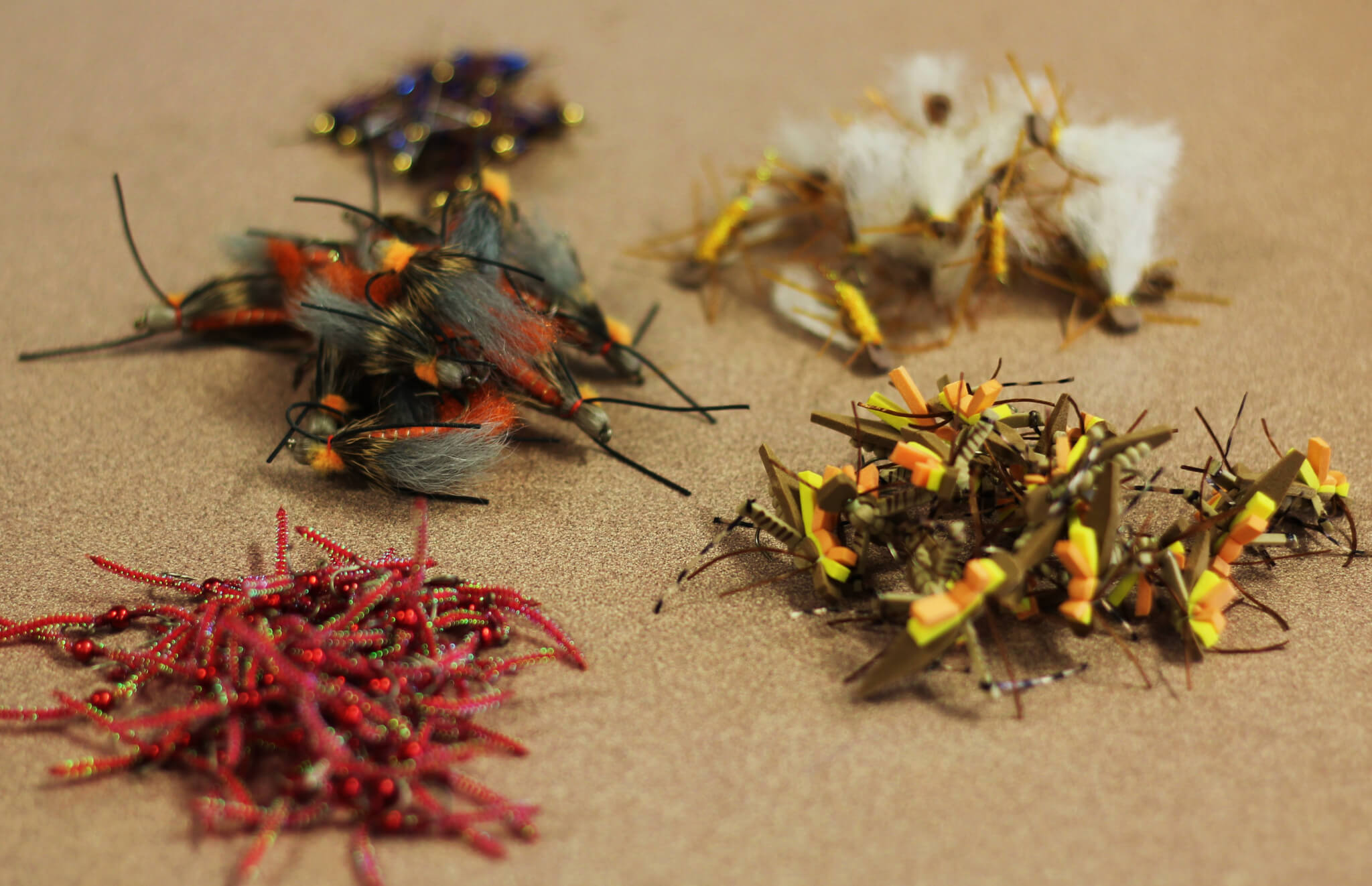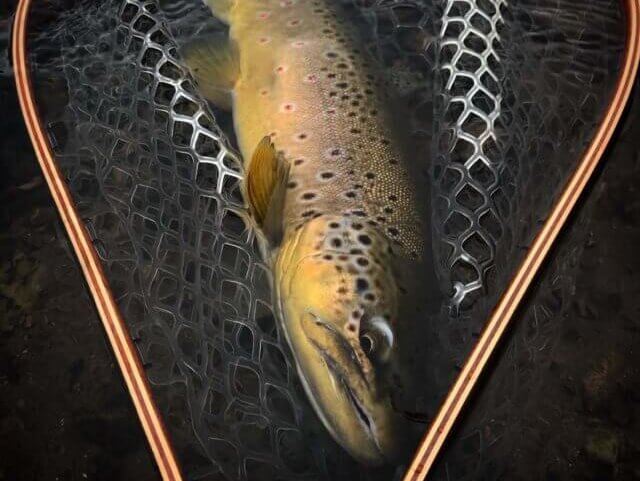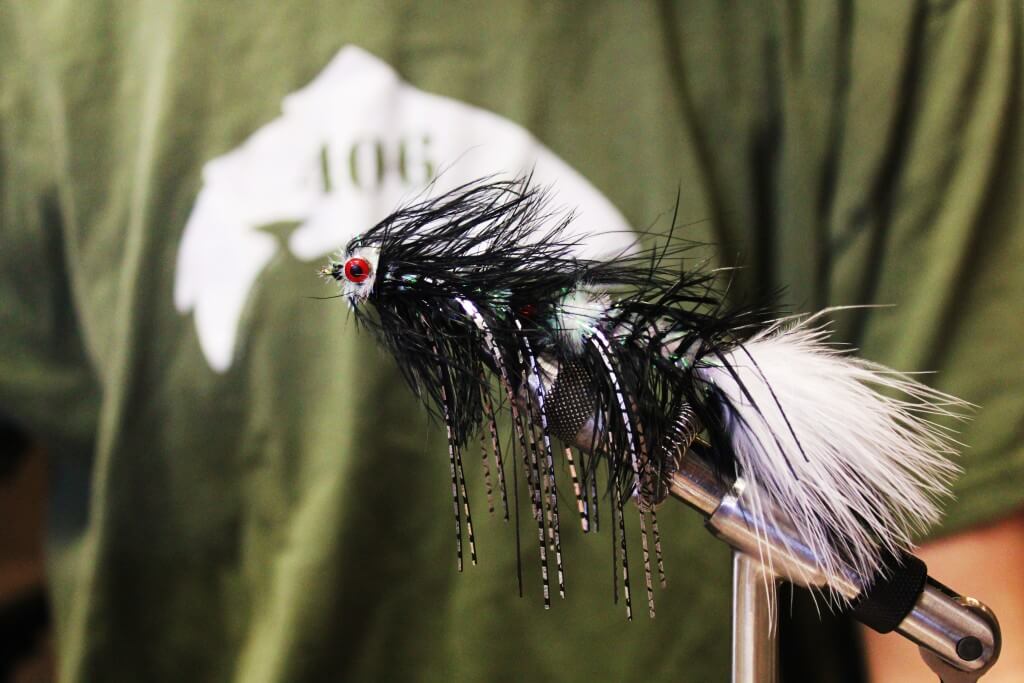Fly Fishing Streamers

Fly fishing streamer is at once the easiest and the most difficult of all fly fishing techniques. At its simplest, it requires you to cast across the current, and allow the current to pull the fly along. You are fishing with what is called a tight line, and if you bump a rock, hit bottom or have a fish take, you will feel it, unlike nymphing or using a dry fly, where the line is slack and you don’t feel the take of the fish. Just cast across and let the current do the work- what could be simpler. Because a streamer imitates a food form that can actually move in the water (unlike nymphs or dries that imitate food forms that can only float with the current), like a minnow or a leech, it is OK for the fly to move counter the current. In dry fly fishing or nymphing, any movement counter to the current is called drag, and is bad. In streamer fishing, movement counter to the current is called action, and is a good thing.
Enticing Fish To Eat Your Streamer
But how do you get a fish to bite a streamer? Now it gets interesting, We have a theory (doesn’t everybody!?) that says the larger the fly, the easier it is to see that it is not a real food form. And because streamers imitate larger food forms, it is easier to see that the streamer is not real. So you will often need to entice the fish into striking (striking is defined as hitting, or eating, the fly). Fish have no hands (again, you get the 411 when you read this entire website), and the only way for a fish to find out if something is food or not is take it into their mouth. Curiosity will often get a fish to strike, so you need to move your fly in a way that will entice the fish to strike.
Some great advice that is relevant to fishing a streamer was found in a book on bass fishing, Bass On A Fly by Jack Ellis. He said, in relation to moving a bass bug, to think of an animal dying, and emulate the action of that dying animal. If you have ever watched a fish dying on the surface, you will see erratic movements, maybe many rapid movements followed by complete inertia, or just a few quivers. When fishing a streamer, this is the best advice you can get. Trout are predators, and they respond to distress signals that an injured fish gives off. A wounded or dying fish is a much easier meal than a healthy one, so imitate the movements of a distressed fish to get more response to your streamer. When you cast a streamer, and give it action, try constantly thinking that you are a dying fish, and try to give your fly the dying action. This is one of many retrieving methods that you should try while streamer fishing, but don’t hesitate to switch up retrieves if this is not producing.
When fishing a streamer, this is the technique used to give a fly action. Make your first cast with relatively little action, maybe a few bumps or tiny tugs. If there is no response to that action, then step it up, giving bigger movements (but always erratically) to the flies. On your last cast through a section of river, rip your streamer along in 3 foot strips, seeing if that can entice the fish. We always start with small movements and progress to big ones, because the smaller movements are less intrusive to the pool. Start with big ripping movements, and you may spook the fish. Start with smaller movements, move onto larger movements, and then let the fish tell you what action they want in their prey. And remember that streamer fishing is the most invasive type of fly fishing, with long casts and big fly movements. If you plan to fish a pool with dries, nymphs and streamers, fish the dry first, so you don’t disturb the water. Then use the nymph, and follow the nymph with the streamer. Dry fly fishing is the least invasive style of fishing, so try it first. Nymphing is a little more invasive, so use that technique second. The last thing to use is a streamer, as it is the most invasive. If you are only going to fish a streamer, just huck it on in there first off.
Classic streamer fishing has the angler standing near the shore, casting downstream at about a 45 degree angle and letting the current take the fly. In this method, the fly stays near the surface, which is not always what is required. We will often cast further upstream, and then mend, allowing the fly to sink more deeply. As said before, trout like to rest near the bottom, and often a deeper streamer will be more effective than a shallow one. So vary the depth by varying how far upstream you cast your fly. When the fly gets about 45 degrees below you, start to give it some action. During this entire process, mend and point the rod tip directly at the fly, with the rod tip low to the water, and sometimes even in the water. Keep the line running through the last 2 fingers of your rod hand, and then strip (move) the line with your left hand, and only give action to the fly by stripping the line with your left hand, never with the rod tip. If you give action to the fly by moving the rod tip, you will often find that the fish strikes when your rod tip is pointed away from the fish, and you can’t strike, because your rod is not in the correct position. Keep the rod tip pointed at the fly, and when the fish hits, you will be in position to strike (rear back) with the rod to set the hook.
When fishing from shore (wading) you cast towards the middle and allow the streamer to come (swing) to the shallows. Make sure you allow the fly to complete its swing, which means the fly line should extend completely below you. Quite often, fish will strike just as the fly moves from the swing to extending directly below you, so make sure you fish out your cast completely. Streamer fishing from a boat is different. You are in the center of the river, casting to the shore. Put your fly as close to the edge as you can, and then move it away from the bank. Remember, 70% of all fish are found within 15 feet of the shore, so keep your fly where the fish are. This is why it is so important to completely fish your cast out when wading, so you fish where the fish are. Streamer fishing can be very effective from a boat, as you show your fly to a lot of fish, and you have a better chance of finding one that will strike. When wading, make sure you vary your depth, so that each fish gets a chance to see the fly.
Choosing Streamer Patterns
There are 2 different types of streamers, imitative and attractors. An imitative streamer, like a sculpin or a Rainbow Baby Gonga, is designed to look like a minnow that a trout may see in the river. Attractors, like a Kreelex or Sparkle Minnow, are designed to look like food, but not necessarily to resemble anything specific. Both are fished the same way, using the same techniques as described earlier, but you need a little more thought when using imitative streamers. Take the sculpin for example. The most important feature of the sculpin is that it doesn’t have a swim bladder, which means it can’t control its depth in the water column, and is forced to live on the bottom. So your sculpin imitation should be on the bottom as well. A sculpin pattern moving along 6 inches from the surface is not a very good imitation of a sculpin. While many fish have been caught on a sculpin pattern 6 inches from the surface, it is not a good imitation. So when fishing an imitation, make sure you know the habits of the fish you are imitating. An attractor can be fished at any depth, because it is not designed to look like a specific fish. Attractors are just designed to look and act like food, which can be found at any depth.
Best Times To Fish Streamers
The best streamer fishing is found in the early spring, then right before run-off, then just after run-off and at the end of the season. Early spring is good because the fish are coming off along dry spell of slow eating, and as the water temps warm up, the fish are looking for calories, and streamers represent a big meal. The same can be said at the end of the season, The fish know a long poor feeding time is coming up, and they start to feed to bulk up for the winter. Pre and post run-off are good fishing because the water is a little off color, and the fish can’t really see the streamer all that well, so you have that advantage. And in the post run-off fishing, you have the additional advantage that fish are again coming off a slow feeding period, and they are hungry. Any time the water is a little off color, streamer fishing is very good. In full run-off streamers are effective, but it is still a struggle.
Off color water brings us back to trout biology. It is in streamer fishing that the trout’s lateral line comes into play. The lateral line is a group of sensors that can detect changes in pressure in the water, some of which are caused by movement. In off color water, a muddler or sculpin is effective because of its bulky head. The head pushes water in front and around it, and those vibrations can be felt by the fish, helping the trout to locate your fly in un-clear water. And because colored water is often high water, weight is usually used, either in the fly or on the leader. A heavy, bulky fly will get to where the fish are in high water, and push enough water to be found by the fish.
But for low and clear situations, such as March and April, or the summer months. You need a slimmer, lighter fly that will not disturb the water as much. The fly that worked so well when the water was high and off-color will now move every fish in the pool- away from your fly. In low water situations, you need a lighter, thinner fly like the Dirty Hippie that will not disturb the water as much. Trout will still eat a minnow in clear water, but you have to adjust your flies to the situation. Off color, heavy and bulky flies. Clear water, slim, lightweight flies.
There are 2 types of streamer fishermen. Those who go to the streamer first, and those who go to the streamer as a last resort. Those who go to the streamer first know just how effective they can be. Those who go to the streamer as a last resort are often un-appreciative of the effectiveness of streamers. The “last resorters” will often fish a dry fly with no success for 4 hours, and then a nymph with no success for 2 hours. Then they try a streamer for a half hour, with no success, and say there is no use in fishing a streamer. Maybe it’s just not good fishing that day, not that streamers aren’t effective. To be an effective streamer fisherman, you need to fish them often, and not as a last resort. Remember the first rule- big fish eat little fish, and streamers move the big fish. Our Missoula fly shop has some serious streamer fisherman, and many of them are not interested in the fish that are eating dry flies, they’re interested in the fish that are eating the fish that are eating the dry flies.
Streamer Fishing History
The streamer is generally considered to be a North American invention.Though probably used by the Macedonians, the first real mention of the streamer was in the fishing gazettes of the 1850’s. But it didn’t get serious until Theodore Gordon, the father of the American dry fly, began writing about his fly the Bumblepuppy, in the early 1880’s. This fly went through many variations, but was basically a white and brown fly. But the streamer fly hit its pinnacle in the 1920’s and 30’s on the famous Land-locked Salmon and Brook Trout rivers in Maine. Here is where the Mickey Finn and the Gray Ghost were invented, and where the beginnings of the classic streamer began. The streamer has since morphed into one of the most beautiful and effective styles of flies available to the angler. From the humble beginnings of the streamer, the streamer has become both an expression of the fly tyers art as well as some of the best imitations of minnows, sculpins and other swimming species.
Definitions of the Streamer The classic definition of a streamer is a long-shanked fly tied with a feather wing. This would be in contrast to the Bucktail, which is again a long-shanked hook with a wing made of bucktail or some other type of hair. But the term streamer has come to mean any type of fly used to imitate a minnow or leech. The streamer now encompasses Woolly Buggers, Articulated Leeches, Double Bunnies and any other myriad of swimming flies.


